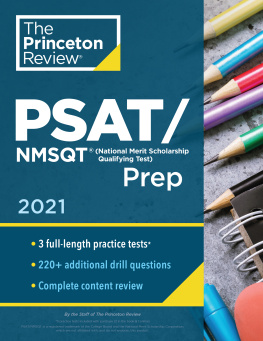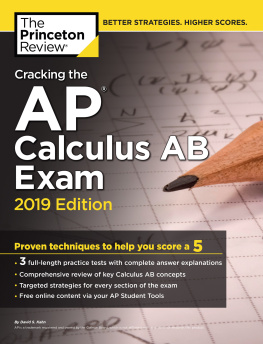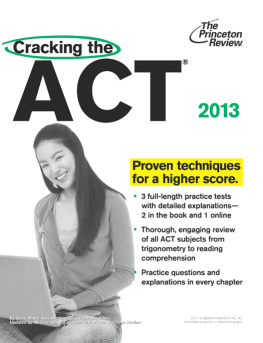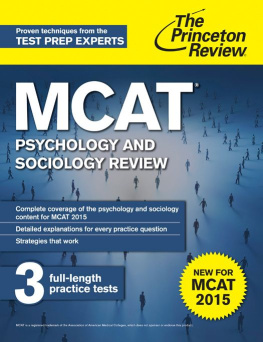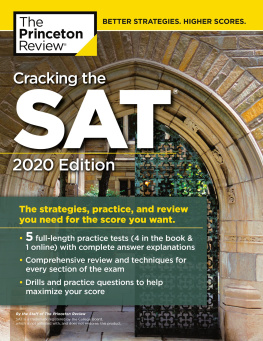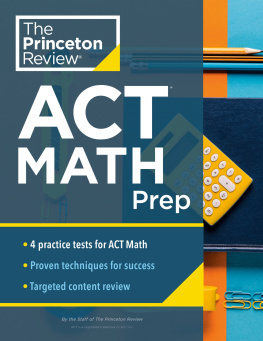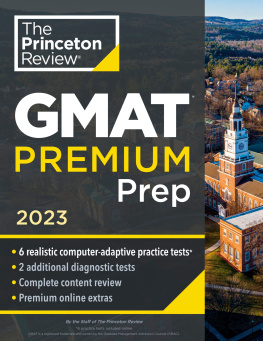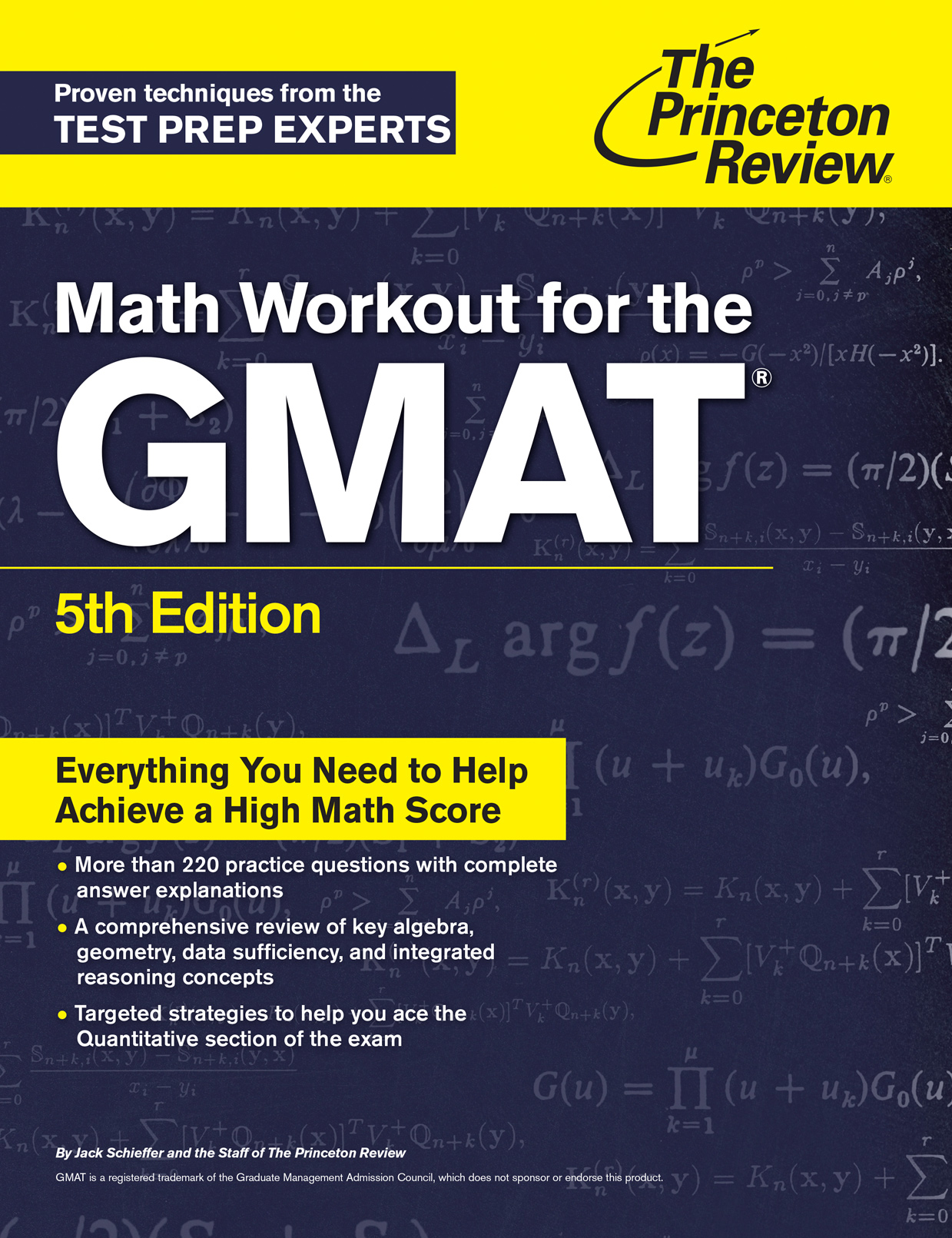Contents
Acknowledgments
Id like to thank all of the people at The Princeton Review, both those Ive known personally and those Ive never met. You have made the big red arrow a fun and interesting place to work, and I have learned a tremendous amount from you over the years. Special thanks go to Jerry Pederson, for hiring me and introducing me to the wacky world of test preparation; to Mike Gamerl, for the long-lasting appellation GMAT Jack; and to John Katzman, for creating The Princeton Review and making this all possible. Thanks also to David Ragsdale, Suzanne Markert, Patricia Dublin, and Marc Williams.
Id also like to thank my family and friends for their love and support. Ive immortalized some of you in story problems in this book, which I hope brings you fame and respect, rather than infamy and embarrassment.
Finally and most importantly, I want to thank my lovely wife, Christina. Your patience with my weird job and general test-geekiness is amazing. You have my love and gratitude forever.
Special thanks to Adam Robinson, who conceived of and perfected the Joe Bloggs approach to standardized tests and many of the other successful techniques used by The Princeton Review.
The Princeton Review would also like to give special thanks to Kyle Fox and John Fulmer for their hard work in revising and updating the current edition of Math Workout for the GMAT .
ABOUT THE AUTHOR
Jack Schieffer has worked at The Princeton Review since 1989. He has taught courses for almost every type of test, and he was the Director of Research & Development for the GMAT course from 1996 to 1998.
WELCOME
So youve just purchased this book to help boost your math skills. You want to get an MBA and you know that you need a good GMAT score to get into your top-choice business school. It may be that your math skills are a bit rusty. For example, you may not have taken many (or even any) math classes in college. These days, you probably use a calculator or computer to balance your checkbook, to crunch numbers at work, and to handle any other calculations that come your way. The result is that you havent really used your math muscles for several years or more. Or maybe you are comfortable with your math skills. Maybe you were the kid everyone cheated off in math class. However, you lack that edge necessary to push you over the top. You need a strong system you can use to reach that elite score. Thats the bad news.
In either case, at least at some point, you did learn the math thats tested on the GMAT. None of the concepts is more advanced than high school algebra and geometry. No trigonometry, no calculus, and no multi-variable regression analysis (whatever that is). Even the most challenging problems dont require you to learn a lot of new stuff; you just need to refresh your memory.
In the following chapters, youll cover the math you need to know for the GMATand only that. If its not on the test, its not in this book. Youll also learn some test-taking strategies specific to the GMAT. This stuff probably wont help you in your first-year statistics course, but it will help you to get there in the first place. In addition, this book includes an introduction to the new Integrated Reasoning section of the GMAT.
THE GMAT AND BUSINESS SCHOOL ADMISSIONS
You already know that you have to take the GMAT to get into business school, but there may be a number of other things youre not so sure about. How important is the GMAT? Whats a good score? What other things do schools consider?
The importance of the GMAT depends on several factors. One is how long youve been out of school. If you graduated a long time ago, say more than five years, then MBA programs will place more weight on your GMAT score than they would if you graduated a year or two ago. Thats because they will de-emphasize your college GPA in considering your application, thereby making your GMAT score more important in the mix.
Another factor in the importance of your GMAT score is the particular GMAT score in question. In addition to the overall score (200800 range), you will receive a separate Math score, Verbal score, Integrated Reasoning score, and AWA (Analytical Writing Assessment) essay score. With the introduction of the new Integrated Reasoning section (as part of the Next Generation GMAT), the scoring breakdown has changed. The Integrated Reasoning section is scored separately from the rest of the test. This section is a blend of math and verbal skills and it is scored on a scale of 1-8 in whole point increments. As far as scoring goes, most schools concentrate on the overall score and the Math score in their admissions decisions. They look at the overall score because its a broad measure of your ability. They look at the Math score because many MBA courses require significant use of quantitative skills, and the schools want to ensure that entering students have the necessary mathematical ability.
A good GMAT score is one that will make you competitive with other applicants to the programs of your choice. Check with the programs youre considering to find out the average GMAT score and GPA for the latest entering class. That GMAT score gives you a good target. If your GPA is below the average, you should shoot for a higher GMAT score to compensate.
Business schools consider many factors in the application process, with GMAT scores, undergraduate GPA, and work experience making up the big three. GPA is fairly self-explanatory, and GMAT scores are discussed above. The work experience factor includes both the length of your full-time experience and its nature. Several years of experience are virtually mandatory for the top programs. Schools like to see leadership roles and increasing responsibility in your career to date.
MBA programs will also look at several other factors, including letters of recommendation and your application essays. Although these elements are not counted as heavily as the three factors discussed above, they are still important. If your big three qualifications are average for a given program, strong essays and recommendations can help you stand out from the pack.
A full discussion of the various criteria in MBA admissions is beyond the scope of this book; it is, after all, a GMAT math review. However, it is important to give due consideration to all of the elements in your application, not just your GMAT scores.
STRUCTURE OF THE GMAT
The GMAT lasts approximately four hours. The test is administered by computer.
The test starts with the AWA essay. You will have 30 minutes to write one essay thats an Analysis of an Argument. The section after the essay is the new Integrated Reasoning section. You will have 30 minutes to answer 12 questions, which sounds like a piece of cake, right? Most of those questions have multiple parts, though. So youll need all of that time to tackle these multi-part questions.


